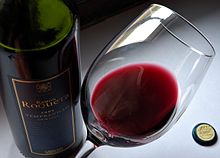ワインの色
ワインの色(ワインのいろ、Wine color)は、最も認識しやすいワインの特徴の一つである。重いワインは一般的に深い色をしており、ワインの色は、ワインのテイスティングの要素の一つとなる。ワインの色を判定する伝統的な道具は、暗いワインセラーの中で液体の色を見られるようにした浅いカップのタートバンである。また色は、ワインの分類の要素となる。

色の起源 編集
ワインの色は、主にブドウの品種の核果の色を依存する。色素は果汁ではなく、外果皮に局在するため、ワイン醸造の方法や、ムストを果皮に接触させるマセレーションの時間の長さに依存する。タントゥリエは例外で、果実のパルプ質にも色素が含まれる。色の異なる2種類以上の品種をブレンドしてワインを使ってワインを作ることもある。
赤い外果皮のブドウから、素早く圧搾し、果汁を果皮と触れさせないことで、白ワインを作ることもできる。ワインの色の大部分は、フェノール化合物(アントシアニジン、タンニン等)等の植物色素のためであり、酸の影響も受ける。また、ワインの熟成中に、活性分子同士の反応によって色が変化し、一般的には、より黄褐色に近い色に褐変する。熟成にオーク等の木製の樽を用いることでも、ワインの色に影響する。
さらに、アントシアニジンとその他の非色素フラボノイドまたは天然フェノールとのコピグメント効果もワインの色の一つの要因となる[1]。
色の変化 編集
アントシアニンとプロシアニジンの複雑な混合物の存在が、ワインの色の安定性を向上させている[2]。
ワインが熟成すると、色素分子に含まれるアセトアルデヒドの自動酸化反応が起こる。新しく形成された分子は、pHや亜硫酸塩漂白に対してより安定である[3]。このような分子には、ビチシンA、ビチシンB、ピノチン、ポルトシン等のピラノアントシアニンやその他のポリマー由来色素が含まれる[4][5][6][7]。
マルビジングルコシドエチルカテキンは、フラバノール-アントシアニン付加物である[8]。フラバノール-アントシアニン付加物は、ブドウ中のアントシアニンとタンニン、及びアセトアルデヒド等の酵母代謝物から熟成中に形成される。アセトアルデヒドの誘導する反応で、マルビジングルコシドエチルカテキン等のエチル結合種が生成する[9][10]。この化合物は、pH5.5で、マルビジン-3O-グルコシド(オエニン)よりも高い安定性を持つ。pHが2.2から5.5に上昇すると、色素の溶液は徐々に紫色になる(pH 5.5でλmax = 560 nm)が、アントシアニンの同様の溶液は、pH4.0でほぼ無色になる[11]。
ワインを限定的な量の酸素に晒す(ミクロオキシジェナシオン)ことはワインに有益な効果をもたらすが、ワインの色にも影響を与える[12]。
カスタビノールは、アントシアニン色素に由来する別の種類の無色の物質である。
モデル溶液では、カテキン等の無色の物質から別の種類の色素ができることがある。第一段階は、2つのフラバノール単位がメチン基で繋がれた無色の二量体の形成である。次の段階で、無色の二量体の脱水、酸化が起こり、キサンチリウム塩の黄色の色素とそのエチルエステルが形成される。脱水は、二量体の2つのA環のヒドロキシ基の間で生じる[13]。
色 編集
ワインの主な色には、以下のようなものがある。
科学的な色の決定 編集
国際ブドウ・ワイン機構は、分光測色法によりワインの色を評価する方法、またLab色空間の指標を計算する方法を提供している[14]。
脚注 編集
- ^ Boulton, Roger (2001). “The Copigmentation of Anthocyanins and Its Role in the Color of Red Wine: A Critical Review”. Am. J. Enol. Vitic. 52 (2): 67–87.
- ^ Céline, Malien-Aubert; Olivier, Dangles; Josèphe, Amiot Marie (2002). “Influence of procyanidins on the color stability of oenin solutions”. Journal of Agricultural and Food Chemistry 50 (11): 3299–3305. doi:10.1021/jf011392b. PMID 12010001.
- ^ Atanasova, Vessela; Fulcrand, Hélène; Cheynier, Véronique; Moutounet, Michel (2002). “Effect of oxygenation on polyphenol changes occurring in the course of wine making”. Analytica Chimica Acta 458: 15–27. doi:10.1016/S0003-2670(01)01617-8.
- ^ Schwarz, Michael; Hofmann, Glenn; Winterhalter, Peter (2004). “Investigations on Anthocyanins in Wines from Vitis vinifera cv. Pinotage: Factors Influencing the Formation of Pinotin A and Its Correlation with Wine Age”. J. Agric. Food Chem. 52 (3): 498–504. doi:10.1021/jf035034f.
- ^ Mateus, Nuno; Oliveira, Joana; Haettich-Motta, Mafalda; De Freitas, Victor (2004). “New Family of Bluish Pyranoanthocyanins”. Journal of Biomedicine and Biotechnology 2004 (5): 299–305. doi:10.1155/S1110724304404033. PMC 1082895. PMID 15577193.
- ^ Mateus, Nuno; Pascual-Teresa, Sonia de; Rivas-Gonzalo, Julián C; Santos-Buelga, Celestino; De Freitas, Victor (2002). “Structural diversity of anthocyanin-derived pigments in port wines”. Food Chemistry 76 (3): 335. doi:10.1016/S0308-8146(01)00281-3.
- ^ Mateus, Nuno; Silva, Artur M. S.; Rivas-Gonzalo, Julian C.; Santos-Buelga, Celestino; De Freitas, Victor (2003). “A New Class of Blue Anthocyanin-Derived Pigments Isolated from Red Wines”. Journal of Agricultural and Food Chemistry 51 (7): 1919–23. doi:10.1021/jf020943a. PMID 12643652.
- ^ Malvidin glucoside-ethyl-catechin on Yeast Metabolome Database
- ^ Morata, A; González, C; Suárez-Lepe, JA (2007). “Formation of vinylphenolic pyranoanthocyanins by selected yeasts fermenting red grape musts supplemented with hydroxycinnamic acids”. International journal of food microbiology 116 (1): 144–52. doi:10.1016/j.ijfoodmicro.2006.12.032. PMID 17303275.
- ^ Asenstorfer, Robert E.; Lee, David F.; Jones, Graham P. (2006). “Influence of structure on the ionisation constants of anthocyanin and anthocyanin-like wine pigments”. Analytica Chimica Acta 563: 10. doi:10.1016/j.aca.2005.09.040.
- ^ Escribano-Bailón, Teresa; Alvarez-García, Marta; Rivas-Gonzalo, Julian C.; Heredia, Francisco J.; Santos-Buelga, Celestino (2001). “Color and Stability of Pigments Derived from the Acetaldehyde-Mediated Condensation between Malvidin 3-O-Glucoside and (+)-Catechin”. Journal of Agricultural and Food Chemistry 49 (3): 1213–7. doi:10.1021/jf001081l. PMID 11312838.
- ^ Caillé, Soline; Samson, Alain; Wirth, Jérémie; Diéval, Jean-Baptiste; Vidal, Stéphane; Cheynier, Véronique (2010). “Sensory characteristics changes of red Grenache wines submitted to different oxygen exposures pre and post bottling”. Analytica Chimica Acta 660 (1–2): 35–42. doi:10.1016/j.aca.2009.11.049. PMID 20103141.
- ^ Es-Safi, Nour-Eddine; Guernevé, Christine; Fulcrand, Hélène; Cheynier, Véronique; Moutounet, Michel (2000). “Xanthylium salts formation involved in wine colour changes”. International Journal of Food Science & Technology 35: 63. doi:10.1046/j.1365-2621.2000.00339.x.
- ^ OIV web site